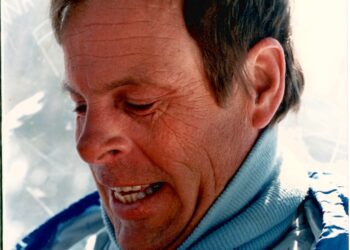Under the weight of mounting challenges, local government alternatives are considered
By Bella Butler EBS STAFF
This is the second installment of a two-part story, and part of a larger examination of leadership and governance in Big Sky. Read Part 1 here.
BIG SKY – Since its rising popularity in the latter half of the 20th century, Big Sky has been patching leaks with duct tape.
In 1992, years before the iconic Lone Peak Tram took its first trip to the 11,166-foot summit, the Big Sky electorate voted in favor of imposing a 3-percent resort tax on luxury goods and services sold in the, at the time, recently established Big Sky Resort Area, a boundary designated by the Montana Department of Revenue. In 1998, the local electorate voted to a create a district for local administration over resort tax.
This monumental action came as much-needed medication to an area that was feeling the growing pains of a kid that grew too fast; in the ‘90s, Big Sky’s sewer system had sprung a leak and as a result the Montana Department of Environmental Quality placed a three-year temporary building moratorium on new construction. In response to the DEQ’s compliance order, Big Sky’s Rural Improvement District 305 was replaced with a county water and sewer district, which has more authority to address such issues.
Resort tax also provided much needed revenue to the unincorporated area at the time and to date around $70 million has been collected.
But some of Big Sky’s early problems are still present, and the strength of the duct tape will continue to be tested; after all, expansion shows no sign of slowing. Experts and locals have begun to question if the status quo of operations in Big Sky will be enough to carry the community into a healthy and sustainable future.
Despite a well-endowed resort tax base, infrastructural challenges continue to arise.
In 2017, the Big Sky Chamber of Commerce was granted $20,000 in resort tax dollars to commission a traffic study, which was conducted by Sanderson Stewart, a Bozeman engineering company. Both Madison and Gallatin counties also provided funding for the study, which in total cost $80,000. The study identified several hazards, including high traffic volumes and unprotected turning lanes on Big Sky’s main artery, Lone Mountain Trail.
In June of 2020, the DEQ acted again in Big Sky, putting a temporary freeze on the approval of new subdivisions in Big Sky due to concerns about the capacity of the Big Sky County Water and Sewer District’s wastewater treatment plant.
Most recently, the public health and economic threats of COVID-19 that plagued the world appeared in various iterations in Big Sky, leaving many in this tourism-based market unemployed as small businesses battled to stay afloat.

Historically most infrastructural issues are resolved, but the solutions are often a product of extensive time and coordination.
After reviewing Big Sky’s water and sewer district documents, the DEQ confirmed in November that the documents demonstrated adequate capacity at the treatment plant. A $10.3 million federal Transportation Investment Generating Economic Recovery (TIGER) grant was awarded to Gallatin County in 2018 to improve the road and bolster public transportation. And the Big Sky Resort Area District, in partnership with several foundations, provided funding for businesses, individuals and public health initiatives in order to stave off further local pandemic tragedy.
Dan Clark, the executive director at Montana State University’s Local Government Center, has conducted work in Big Sky for about a decade. In 2018, the Chamber hired Clark to produce a report exploring local government options for Big Sky.
According to Clark, it’s perhaps not so much that Big Sky’s problems aren’t being solved, but rather that the efficiency, or potential lack thereof, in the solutions process may need further examination.
“[Having] a lot of organizations requires a lot of leadership, and is that the best and most efficient use of all those talents?” Clark asked during a Nov. 11 interview with EBS. “Is it possible that we could … consolidate the energy that’s invested in managing the community and to delivering all these services?”
Furthermore, Clark posed two important questions: Is there currently an efficiency in energy? And is there an effectiveness in communication within this complex network of leaders?
“I think here is this unmet potential that’s still on the table,” he said.
Candace Carr Strauss, current CEO of the Chamber, celebrates the coordination and leadership efforts put forth by the various leaders in Big Sky and holds the TIGER grant example up as a proud picture of what her organization and others are capable of achieving in Big Sky.
While it’s the standard role of a chamber of commerce to be the voice of local business, Carr Strauss believes that because local business is so intertwined with community, and because the Chamber receives public funding through resort tax, the Chamber is obligated to serve the greater community beyond business.
These additional responsibilities, though, are not without cost.
“If you go out and talk to my peers, we’re all exhausted,” Carr Strauss said in an August interview with EBS, referencing specifically the pandemic challenges over the past nine months. Carr Strauss has since submitted her resignation from the Chamber, effective in February 2021. “We’re burning the midnight oil to ensure that we survive and come out as whole as we can on the other side.”
While the commonly assumed antithesis of Big Sky’s libertarian model is incorporation, Clark suggests that the community should first build out a pathway toward broaching the topic of incorporation. He says asking questions about the current status quo is step one: examining issues presently facing the community and questioning the efficacy and efficiency in their handling.
While Clark told EBS in November that incorporation is “one of the more viable” leadership options for Big Sky, Clark’s 2018 report puts a spread of options on the table. Clark was asked by the Chamber to exclude incorporation from his report.
According to Carr Strauss, the Chamber requested Clark examine how the community of Big Sky could better use the tools already available in order to facilitate more collaborative local governance and was specifically asked to omit incorporation as an option in order to avoid duplicating past efforts and to consider community management through systems already in existence.
Clark’s report details six potential leadership options for Big Sky, three of which he called “top options” and three he described as “less likely of a fit for Big Sky.”
The three most feasible options Clark’s report proposed were a Community Council, a Special or Multi-Jurisdictional District, or the currently existing Big Sky Resort Area District, but with some operational modifications.
In a Community Council scenario, the Gallatin County Commission or voters would choose representatives to serve on the council, but the council would be an “official subdivision of county government. Advisory to county commission only,” according to Clark’s report. No such commission currently exists, but specific councils such as the Zoning Planning Advisory Committee perform similar advisory service on special topics.
A Special or Multi-Jurisdictional District would not be recognized as a municipality either and representatives would be determined in a similar fashion as the Community Council. According to Clark’s report, “Districts may employ people, purchase equipment, enter into contracts, receive funds, construct, improve or maintain property and provide grants in support of purpose of district.”
Big Sky could also consider two modifications to the currently existing resort tax board’s operations, Clark’s report states. First would be to shift the focus from funding the strategic planning efforts of other organizations to funding projects that align with a more collective community plan. Another more difficult option, Clark wrote, would be to approach the Montana Legislature about providing broader powers to resort area tax districts.
Clark said over the years he’s learned to discuss this concept in terms of tradeoffs. Unlike pros and cons, tradeoffs are never good or bad, he says, but rather a choice.
Several tradeoffs exist when considering alternative government and leadership in Big Sky, Clark said: problems that would subside and those that might emerge. Considering these tradeoffs is part of building out the path toward bigger, more concrete questions, Clark suggests. At the end of the path, one looming question, he said, still remains.
“I don’t think the question is ever going to go away until it’s actually asked,” he said. “The question of incorporation.”
Brandon Walker contributed reporting to this article.
Follow EBS as we continue reporting on the ongoing examination of governance and leadership in Big Sky.














